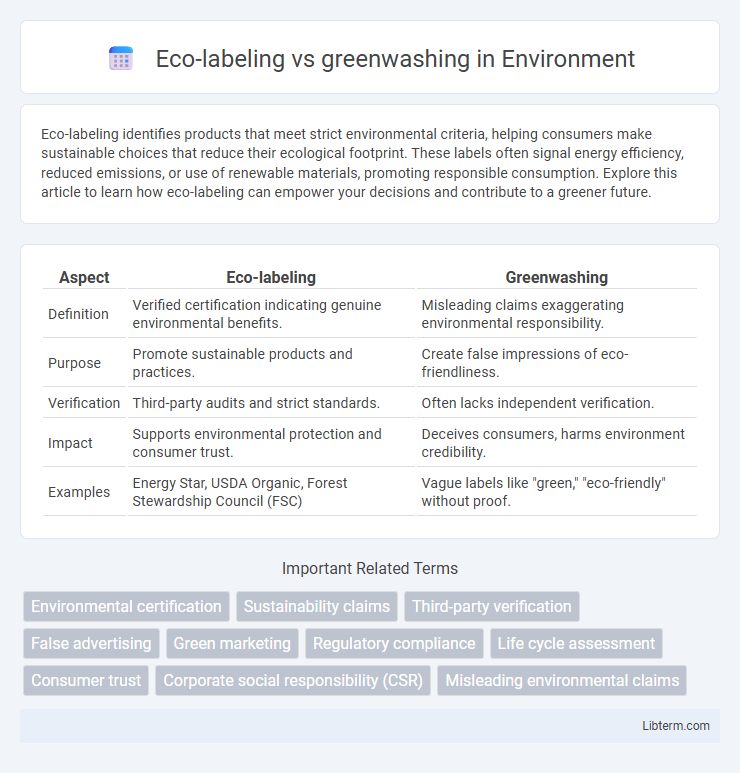Eco-labeling identifies products that meet strict environmental criteria, helping consumers make sustainable choices that reduce their ecological footprint. These labels often signal energy efficiency, reduced emissions, or use of renewable materials, promoting responsible consumption. Explore this article to learn how eco-labeling can empower your decisions and contribute to a greener future.
Table of Comparison
| Aspect | Eco-labeling | Greenwashing |
|---|---|---|
| Definition | Verified certification indicating genuine environmental benefits. | Misleading claims exaggerating environmental responsibility. |
| Purpose | Promote sustainable products and practices. | Create false impressions of eco-friendliness. |
| Verification | Third-party audits and strict standards. | Often lacks independent verification. |
| Impact | Supports environmental protection and consumer trust. | Deceives consumers, harms environment credibility. |
| Examples | Energy Star, USDA Organic, Forest Stewardship Council (FSC) | Vague labels like "green," "eco-friendly" without proof. |
Understanding Eco-Labeling: Definition and Purpose
Eco-labeling is a certification system designed to identify products and services that meet specific environmental standards, promoting sustainable choices among consumers. It provides transparent information about the ecological impact of goods, aiming to reduce environmental harm and encourage responsible production. Unlike greenwashing, which falsely markets products as eco-friendly, eco-labeling ensures verified claims through rigorous assessments and third-party certifications.
What is Greenwashing? Key Characteristics
Greenwashing is a deceptive marketing practice where companies falsely promote their products or services as environmentally friendly to appeal to eco-conscious consumers. Key characteristics include misleading claims, lack of transparent and verifiable environmental data, and superficial or irrelevant sustainability efforts that do not significantly reduce environmental impact. Unlike authentic eco-labeling, greenwashing undermines trust and hinders genuine progress toward environmental sustainability.
The Importance of Authentic Eco-Labels
Authentic eco-labels provide transparent criteria verified by independent organizations, ensuring consumers can reliably identify genuinely sustainable products. Unlike greenwashing, which uses misleading claims to falsely portray environmental responsibility, authentic eco-labels promote accountability and trust in eco-friendly marketing. Recognized certifications such as Energy Star, USDA Organic, and Forest Stewardship Council (FSC) play a critical role in encouraging sustainable consumer behavior and supporting environmental protection initiatives.
Common Examples of Greenwashing Practices
Common examples of greenwashing practices include misleading labels that falsely claim products are eco-friendly, such as vague terms like "natural," "green," or "eco," without verifiable certifications. Companies often use attractive packaging with images of nature to imply sustainability, while their manufacturing processes may still rely heavily on non-renewable resources or harmful chemicals. Another frequent tactic involves highlighting one minor environmental benefit to distract from a product's overall negative ecological impact, misleading consumers about its true environmental footprint.
How to Identify Genuine Eco-Labels
Genuine eco-labels are certified by reputable organizations following strict environmental standards, ensuring transparency and accountability in their criteria. Look for third-party verification symbols, clear information on the product's sustainability aspects, and consistency with recognized environmental certifications such as Energy Star, USDA Organic, or Fair Trade. Avoid vague claims or labels without credible certification, as these are often indicators of greenwashing designed to mislead consumers about the product's ecological impact.
Impact of Eco-Labeling on Consumer Choices
Eco-labeling significantly influences consumer choices by providing transparent information about a product's environmental impact, encouraging more sustainable purchasing decisions. Verified eco-labels build consumer trust and differentiate genuinely green products from misleading claims, reducing the prevalence of greenwashing. Studies show that shoppers increasingly favor eco-labeled goods, driving demand for environmentally responsible production practices.
Risks and Consequences of Greenwashing
Greenwashing poses significant risks including consumer deception, brand reputation damage, and legal consequences for false environmental claims. It undermines genuine eco-labeling efforts, reducing consumer trust in sustainable products and hindering market growth for truly green businesses. Persistent greenwashing can lead to stricter regulations and increased scrutiny on all environmental claims, raising compliance costs across industries.
Regulatory Frameworks for Eco-Labeling
Regulatory frameworks for eco-labeling ensure transparent criteria and third-party verification to authenticate environmental claims, minimizing the risk of greenwashing. Governments and organizations like the International Organization for Standardization (ISO) develop standardized guidelines, such as ISO 14024, to certify products with credible environmental labels. These regulations foster consumer trust and promote genuine sustainability by distinguishing verified eco-friendly products from misleading green marketing.
Building Consumer Trust: Transparency and Accountability
Eco-labeling enhances building consumer trust by providing verifiable certifications that confirm a product's environmental claims, ensuring transparency and accountability in marketing practices. Greenwashing undermines this trust by presenting misleading or false eco-friendly claims, creating confusion and skepticism among consumers. Transparent third-party verification and clear communication of sustainability standards are crucial to differentiating genuine eco-labels from deceptive greenwashing tactics.
Future Trends in Eco-Labeling and Sustainability Marketing
Future trends in eco-labeling emphasize increased transparency and standardized criteria to combat greenwashing, ensuring that sustainability claims are credible and verifiable. Advances in blockchain technology and AI enable real-time tracking and authentication of eco-labels, enhancing consumer trust and regulatory compliance. The integration of lifecycle assessments and carbon footprint metrics into labels will drive more informed purchasing decisions and promote genuine environmental accountability in sustainability marketing.
Eco-labeling Infographic

 libterm.com
libterm.com